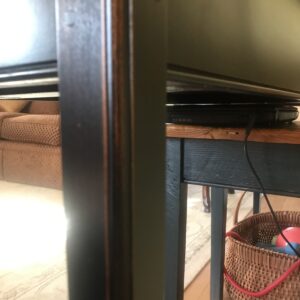I’m making a small Shaker-evocative corner table with tapered legs. I’d like to add an edge detail as shown in the accompanying photo, but am stumped as to how. I thought to use a small (3/16” or so) beading bit with the router table, but that creates a bead on something of a stalk. Not unattractive, but too fragile for the outer edge of a table leg. Suggestions as to the appropriate bit invited and appreciated.
Discussion Forum
Get It All!
UNLIMITED Membership is like taking a master class in woodworking for less than $10 a month.
Start Your Free TrialCategories
Discussion Forum
Digital Plans Library
Member exclusive! – Plans for everyone – from beginners to experts – right at your fingertips.
Highlights
-
Shape Your Skills
when you sign up for our emails
This site is protected by reCAPTCHA and the Google Privacy Policy and Terms of Service apply. -
 Shop Talk Live Podcast
Shop Talk Live Podcast -
 Our favorite articles and videos
Our favorite articles and videos -
E-Learning Courses from Fine Woodworking
-
-
 Fine Woodworking New England Event
Fine Woodworking New England Event -













Replies
Are we looking at the brown leg in the foreground or the blue apron in the background?
The brown leg in the foreground. Apologies for the mixed content. Cell-phone camera has its limitations. There’s a shallow fillet on each outside edge with an eighth-round radius at what would be the outer corner. Thanks for the response.
Not sure which you meant. The leg looks like it has a thumbnail or quarter round detail on the corner. The aprons have a 3/16 or 1/4 inch bead on the lower edge.
It’s what you have identified as the “thumbnail.” Thanks for the reply.
“[Deleted]”
bull nose bit
https://www.whitesiderouterbits.com/collections/beading-bits
That first pic looks like a cock bead, but not sure. You will run this bit on both sides to create if that is the case. The 2nd pic looks more like MJ's solution.
https://www.whitesiderouterbits.com/collections/edge-beading-bit/products/3240
In either case you could also easily make a scratch stock from a cabinet scraper and scratch it in, which would be more appropriate for a Shaker piece.
Yes. Use the round over bit that MJ referenced. To get the step on each side, just set the bit to cut a bit deeper each way. Be sure to use a bearing size that allows for the step or remove the bearing and use the table fence and router depth of cut adjustments.
If it matters, I'm not sure that the edge treatment you propose is stylisticly correct for shaker furniture. Some one correct me if I'm wrong.
All replies appreciated. The “thumbnail” description was the key for me. The profile became obvious considering the time I spend looking at the cutting edges of my bowl gouges. I just wasn’t picturing them upside down. Thanks!
+1 on the bullnose bit
This forum post is now archived. Commenting has been disabled